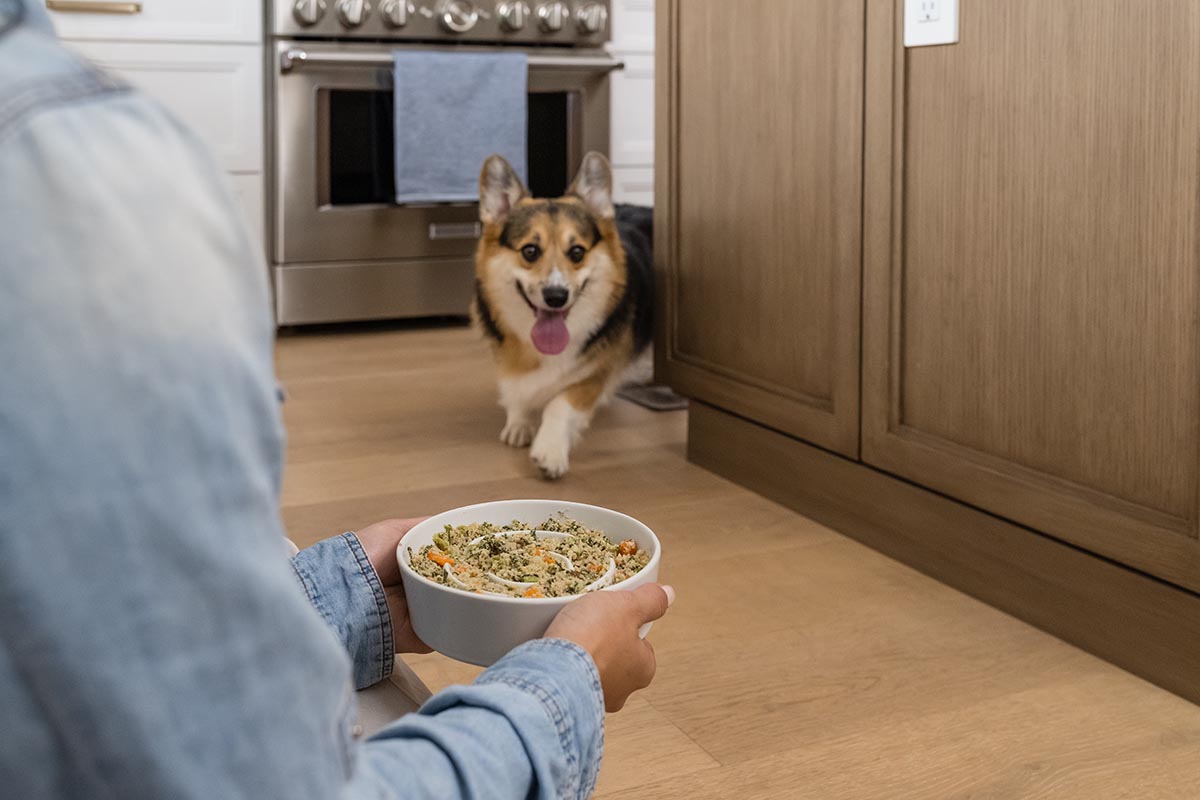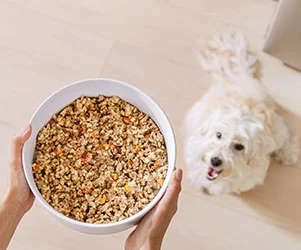Summary
-
Many commercial pet foods are never actually fed to real dogs in feeding trials — nutritional adequacy claims may be based on formulation only.
-
AAFCO feeding trials are considered the “gold standard,” but are optional, involve only a small number of dogs, shorter time frames, and limited bloodwork.
-
JustFoodForDogs ran their own trial with real companion dogs living at home, longer duration (12 months vs. AAFCO’s 6), and more comprehensive testing.
-
The results: all trial dogs remained healthy, passed extensive blood and chemistry panels, supporting claims of long‐term safety and nutritional adequacy.
Did you know that many pet foods are formulated, sold, and fed to your pets without being field-tested or fed to any animals? In the world of dog food, the “gold standard” in research to prove nutritional adequacy is an (optional) feeding trial executed according to the protocols outlined by the Association of American Feed Control Officials (AAFCO).
According to board-certified veterinary nutritionists involved in JustFoodForDogs’ inception, the guidelines for dog and cat food provided by AAFCO are rudimentary at best. With the help of experts at the University of Cal Poly Pomona’s Animal and Veterinary Sciences Department, we developed a better, more robust, and more humane way of conducting feeding trials on dogs.
Do All Pet Food Manufacturers Conduct Feeding Trials?
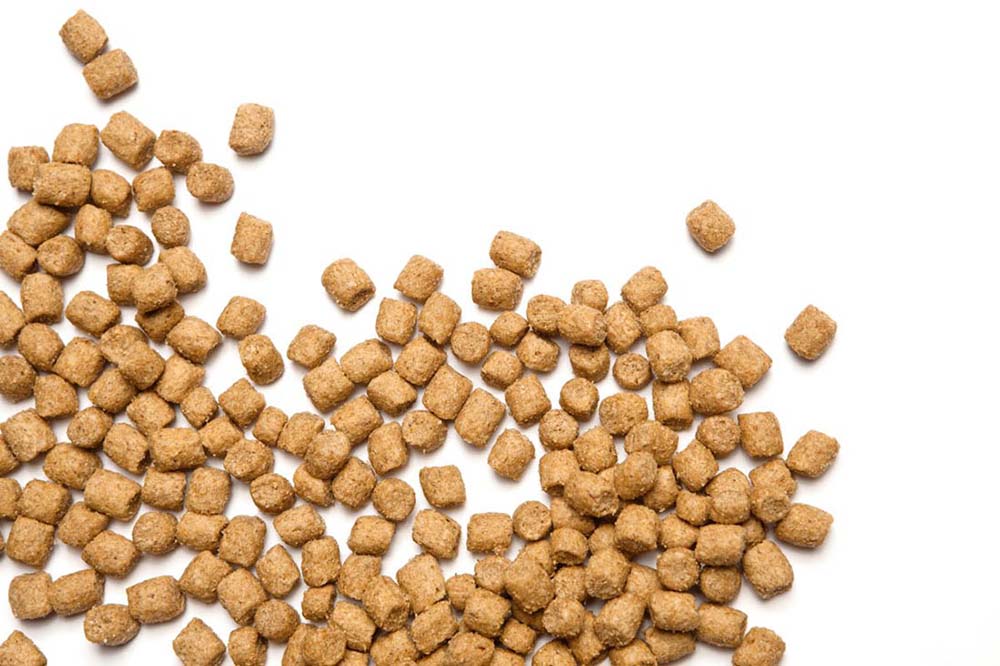
According to board-certified nutrition experts Joseph J. Wakshlag DVM, PhD, DACVN, DACVSMR and Justin Shmalberg DVM, DACVN, DACVSMR, approximately 80% of the pet food industry does not perform feeding trials with their foods.
Believe it or not, feeding trials are not required. The food you feed your dog may have never been officially researched and tested before. To find out, the World Small Animal Veterinary Association (WSAVA) guidelines can help pet owners make an informed decision when choosing the best food for their pet’s nutritional needs.
Dogs Used in Standard Feeding Trials
The way the feeding trials are typically carried out runs contrary to our approach at JustFoodForDogs. The industry norm is to use a “colony of dogs” that are “purpose-bred” specifically for this kind of research. These are dogs that routinely live in a facility their entire lives. They are born and live for the purpose of testing.
Instead, JustFoodForDogs’ study with Cal Poly Pomona used volunteer dogs living normal canine lives in their own homes throughout the testing. It included a variety of breeds and sizes, ranging in age from one to five.
According to Dr. Broc Sandelin, PhD, the former Chair of the Animal and Veterinary Sciences Department, “The field method we developed takes significantly more effort than the standard ‘industry approach,’ but to JFFD it was absolutely worth it. The dogs are happy, and the data are scientifically valid.”
JFFD’s version of the industry standard feeding trial prioritized the quality of life of the trial dogs, while also providing much-desired real-world data from the volunteer pets and pet parents. We are very proud to be the first dog food company in history to successfully complete the standardized AAFCO feeding trials using real companion dogs in their own homes.
AAFCO Feeding Trials vs. JustFoodForDogs’ Feeding Trial
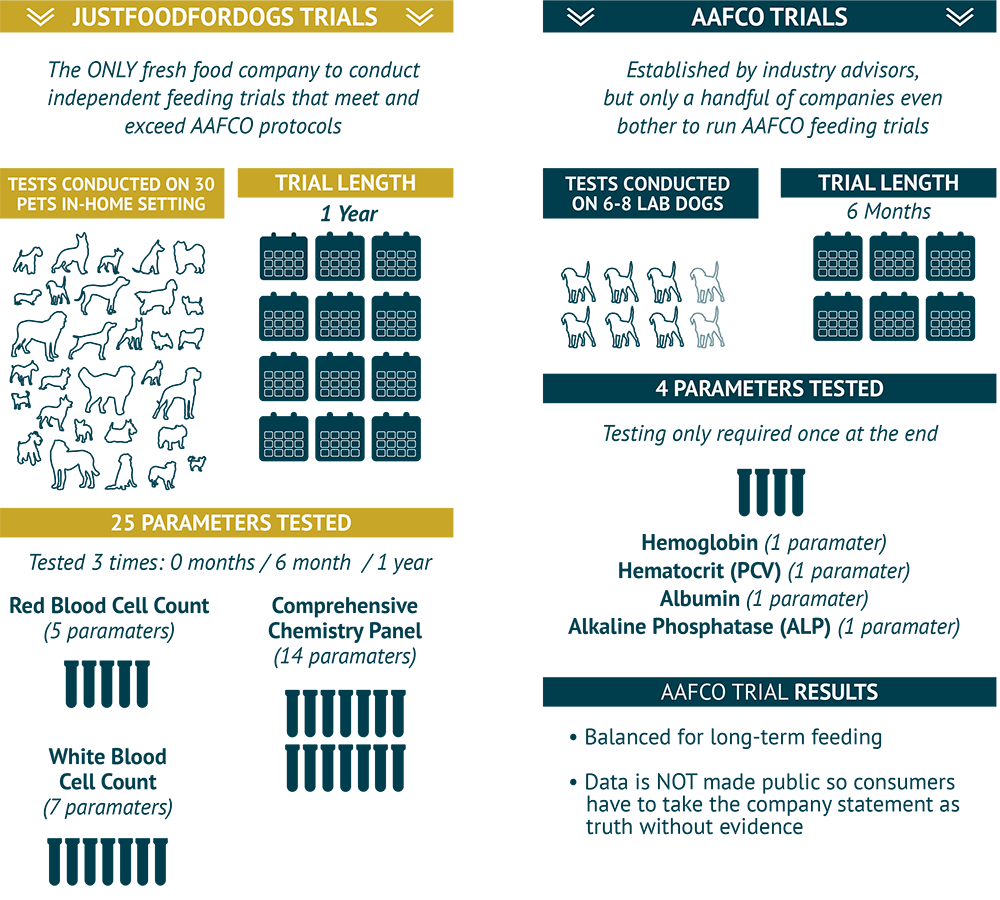
To ensure dog owners are getting the best human-grade pet food products available for overall health, JFFD did:
- 12-month vs. AAFCO’s 6-month trials
- Full complete blood count (CBC) analysis vs. only the 4 measures required by AAFCO
- 30 dogs required to finish the trials vs. 6 adult dogs (at least a year of age) required by AAFCO
Dr. Oscar Chavez, DVM, stated, “AAFCO requires testing of four blood parameters. We took it a step further by testing a complete blood cell count and a comprehensive chemistry panel looking at over 25 blood parameters. We are proud to report every single dog passed the feeding trial on both a group and an individual basis. All participants were found to be happy and healthy, and a majority offered to volunteer again.”
Why a 12-month animal feeding test and not six? Frankly, nutritional deficiencies and other health issues can take longer to develop than in a six-month trial period. AAFCO protocol simply doesn’t cover an adequate amount of ground.
What blood parameters are evaluated in feeding trials?
“Most veterinarians and scientists agree that AAFCO feeding trials can miss identifying deficiencies that take longer than six months to develop or are not detectible by the rudimentary bloodwork required in the protocol. Simply put, if you test for a short enough period and you examine only minimal bloodwork, you may not ever see deficiencies that might exist.”
Shawn Buckley, Founder, JustFoodForDogs
AAFCO requires the average of four blood values fall within acceptable levels. The blood parameters tested are: Hemoglobin, packed cell volume, serum alkaline phosphatase, and serum albumin. The test fails if dogs show signs of nutritional deficiency or toxicity.
JFFD’s blood tests and research found that not only were the recipes beneficial for long-term feeding, but they also promoted healthy functioning of the immune system in dogs.
The data from the JFFD trials was eventually published in the Journal of Animal Physiology and Animal Nutrition and presented at the 2014 AAVN/ACVIM veterinary conference in Tennessee.
Putting Thorough Feeding Trials into Practice

Feeding trials are considered the superior method for establishing nutritional adequacy in the pet food industry. Our trials were executed using a humane method developed exclusively at Cal Poly Pomona University.
We are proud to include the affidavits issued by Cal Poly alongside our labels for each diet. This is why you see the more reliable and higher quality nutritional adequacy statement on each of our daily diets.
We are committed to improving the health and happiness of dogs at all life stages through proven nutrition. JustFoodForDogs diets are the subject of various ongoing research initiatives that look at the impact of whole food on health and wellness and chronic disease. Pet owners can learn more at our research page.
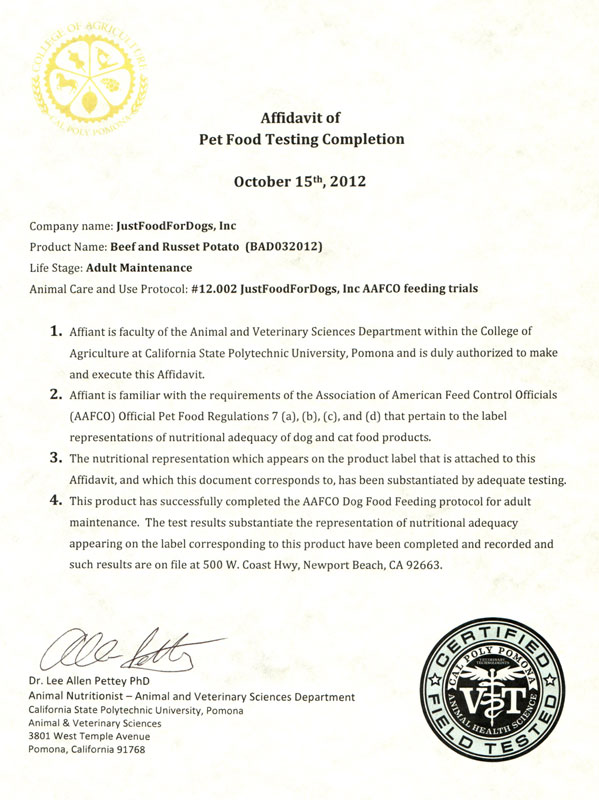
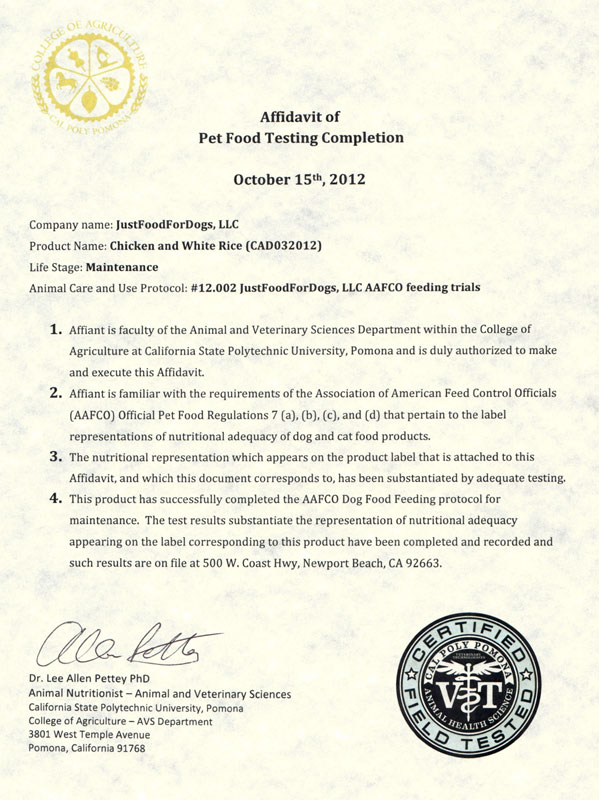
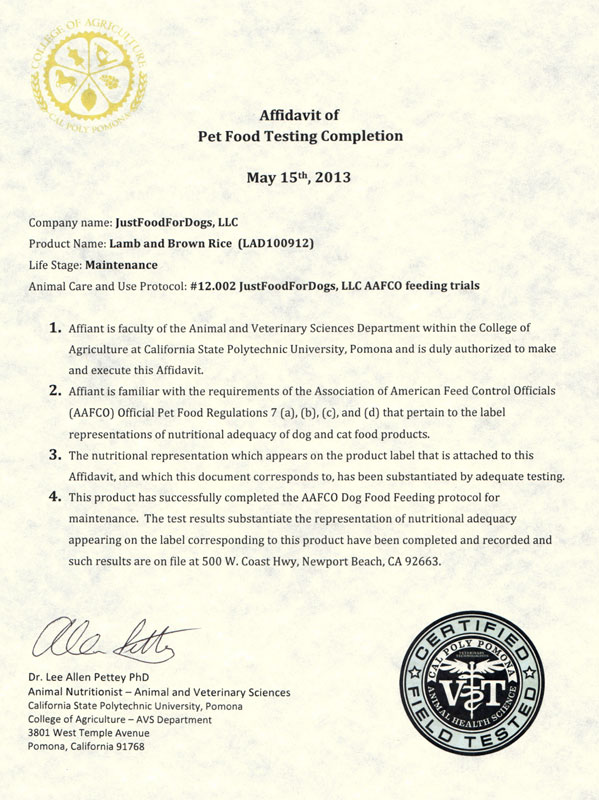
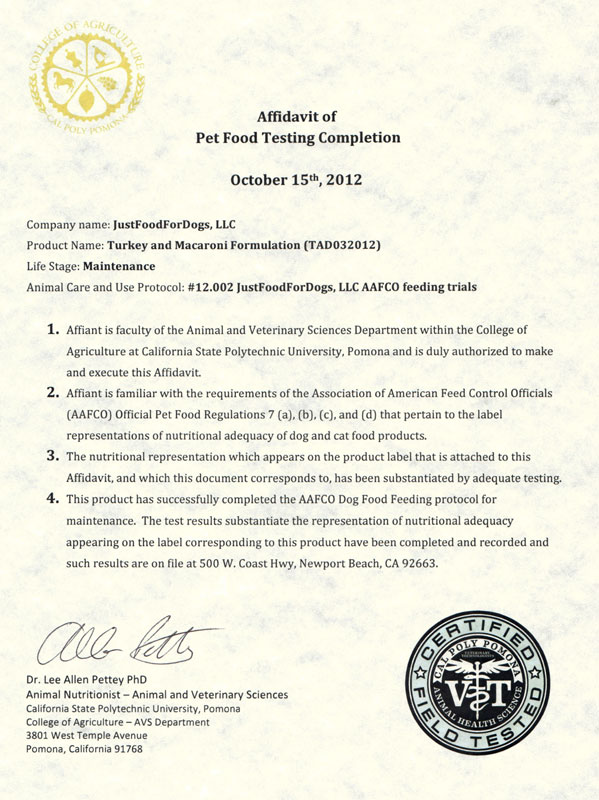
Sources
Beaton, Lindsay. 2022. “The Expectations and Limitations of Feeding Trials.” PetfoodIndustry. August 2022. https://www.petfoodindustry.com/pet-food-market/article/15468983/the-expectations-and-limitations-of-feeding-trials.
“Abstract.” 2014. Journal of Animal Physiology and Animal Nutrition 98 (6): 1187–1201. https://doi.org/10.1111/jpn.12269.
Wakshlag Dvm, Joseph, and Justin Shmalberg. n.d. “AAFCO Feeding Trials: Realities.” Accessed September 16, 2025. https://cashmerevetclinic.com/wp-content/uploads/2019/07/Position-Papers-AAFCO-Feeding-Trials1.pdf.

